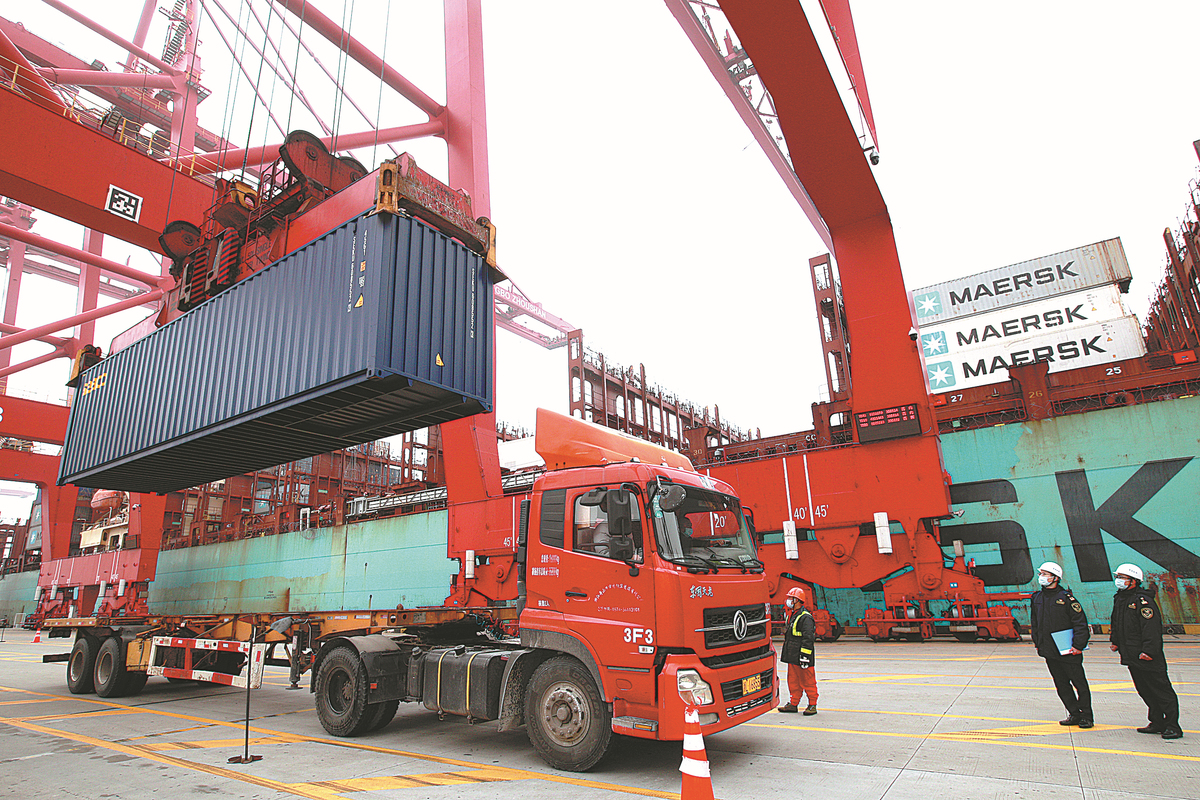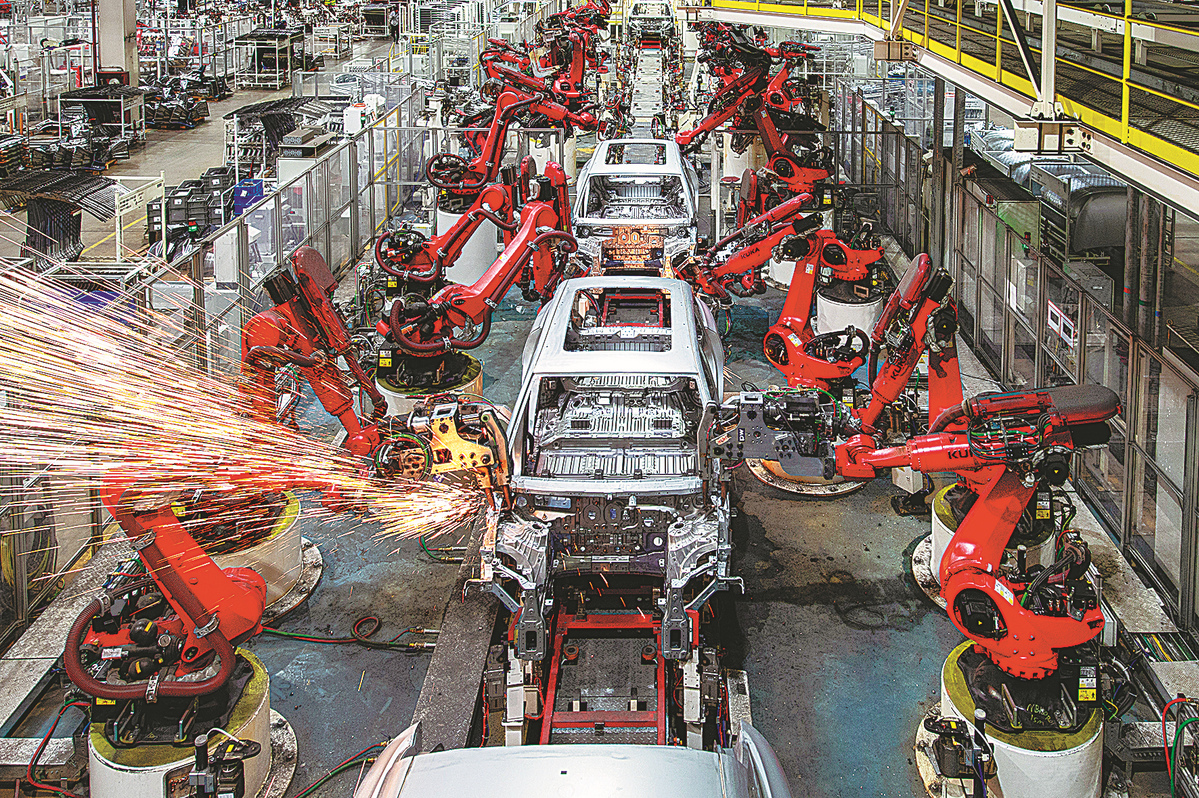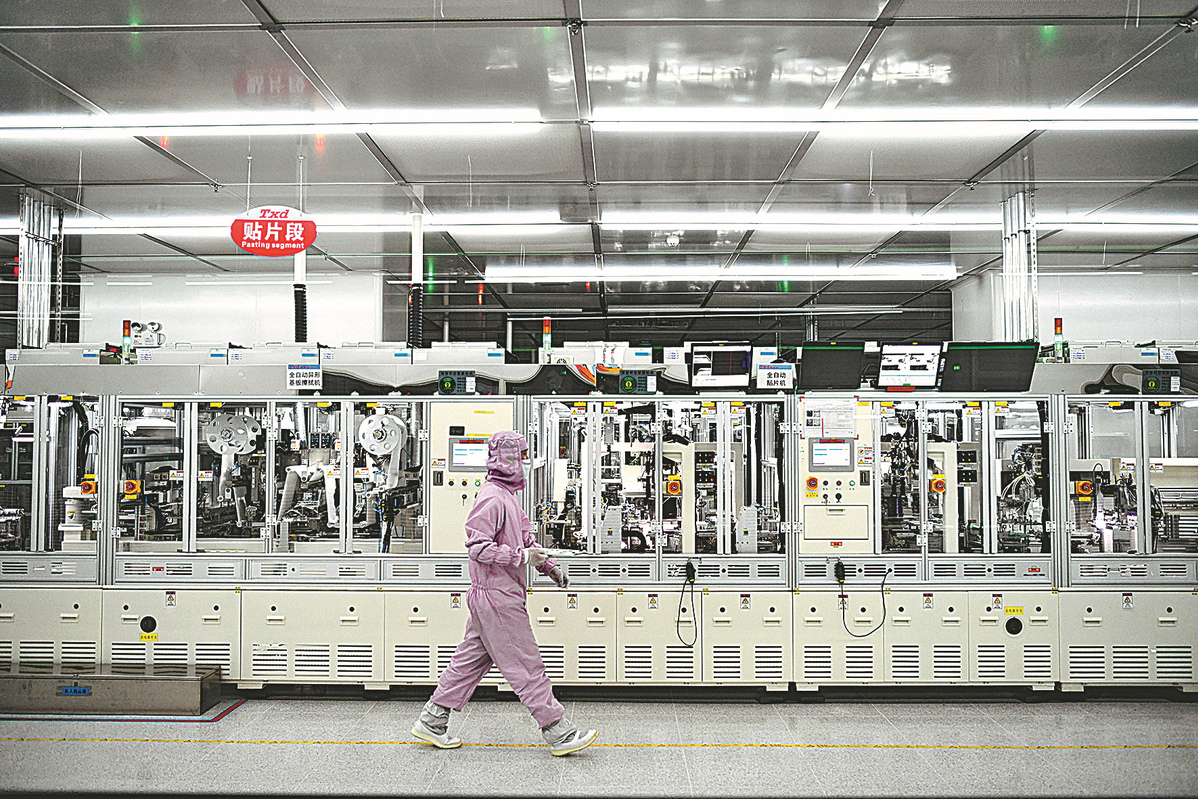Lawmakers to stress stability, infra investments

Two Customs officials (right) watch a crane load an export-bound container onto the vessel Maersk Danube (in the background) at the Ningbo-Zhoushan Port in East China's Zhejiang province on Jan 25. [Photo by Yao Feng/For China Daily]
Two sessions likely to ponder 5.5% GDP target amid recovery and tech advances
China Construction Second Bureau Installation Engineering Co Ltd, a Beijing-based construction company, began this year on a confident note, landing as many as four big-ticket infrastructure contracts worth 350 million yuan ($55.3 million) in all, including one for an airport satellite terminal project in Chongqing that is expected to have one of the world's busiest annual passenger flows.
That January saw a nearly 10 percent year-on-year growth in the value of the company's new infrastructure projects comes as no big surprise as the country has been sharpening its focus on stabilizing growth mainly through investments in priority areas like infrastructure.
It is a theme that will likely dominate the economic policy agenda of the nation's top legislature and top political advisory body when they meet for the annual "two sessions "in the first half of March.
As if in anticipation of a sustained boom in infrastructure, an index tracking A-share infrastructure construction companies provided by China Securities Index Co Ltd grew by 7.16 percent to 4666.12 points from the beginning of the year to Feb 18, even though the benchmark Shanghai Composite Index shed 4.09 percent during the same period.
Fan Yufeng, general manager of China Construction Second Bureau Installation Engineering Co, is pleased that ramped-up investments in infrastructure across the country have given the company's expansion "a shot in the arm".
In the run-up to the two sessions, the tone-setting Central Economic Work Conference in December saw the country's leadership vowing to safeguard economic stability, as GDP growth softened in the second half of 2021 amid threefold pressure from shrinking demand, supply shocks and weaker expectations. In 2021, China's economy grew by 8.1 percent to 114.37 trillion yuan.
So, come March, the two sessions may set the 2022 GDP growth target at around 5.5 percent, said political advisers, economists and business leaders.
To achieve the target, the two sessions may stress speeding up investments in infrastructure, green transition and technological advances, unveil tax cuts of a greater amount compared with last year, and imply moderate monetary policy supports going forward, they said.

An NEV production line outputs smart electric vehicles in Jinhua, Zhejiang province, on Feb 17. Proceeds from local bonds will fund transportation, energy and green projects. [Photo by Hu Xiaofei/For China Daily]
"Stability will be the top focus of economic policies this year," said Zhang Lianqi, a member of the Standing Committee of the 13th National Committee of the Chinese People's Political Consultative Conference. A 5 percent GDP growth could be the bottom line, and the country may set this year's GDP growth target at around 5.5 percent, he said.
Kang Yong, chief economist at KPMG China, also said this year's GDP growth target may be around 5.5 percent, based on the regional economic growth targets unveiled by local governments.
All the 31 provincial-level regions in the Chinese mainland have announced their regional annual economic growth targets. The targets of 29 regions were above or around 5.5 percent year-on-year. Only Beijing and Tianjin aim to achieve regional economic growth of "more than 5 percent" this year.
"A growth target of around 5.5 percent would mark a decline from last year's 8.1 percent growth and even the lowest level in years. Yet, the target would still reflect stable economic conditions," said Kang.
This is because last year's fast growth was exceptional and mainly attributable to the super-low comparison base in 2020 due to initial COVID-19 lockdowns, he said.
On the two-year average basis that corrects the distortion of comparison bases, China's economy grew by 5.1 percent in 2021. A GDP growth target of around 5.5 percent would, therefore, indicate the economy may even accelerate compared with last year, Kang said.
Other experts said a key pillar to underpin such acceleration will be investment in infrastructure. Serving as an effective buffer against a potential slowdown in export growth, infrastructure investment may register an annual growth of high single digits or even double digits, thanks to governmental push, versus last year's 0.4 percent growth.
"With consumption growing mildly due to lukewarm job and wage growth, the engine of growth for 2022 has to be infrastructure investments," said Iris Pang, chief China economist at Dutch bank ING.
Pang said she expects infrastructure investment to grow by around, or even more than, 10 percent this year, backed by the funding of local government special bonds, whose annual quota-to be unveiled at the two sessions-may total between 3.46 trillion yuan and 3.96 trillion yuan, versus 3.65 trillion yuan last year.

A worker walks across a digital manufacturing workshop of an electronic technology company in Ganzhou, Jiangxi province, on Feb 19. [Photo by Zhu Haipeng/For China Daily]
Official data showed that the country allocated 1.46 trillion yuan of the 2022 local government special bond quota in advance last year to spur infrastructure investments, with 484.4 billion yuan in special bonds having been issued in January. The bond proceeds will be used mainly in nine areas, including transportation, energy and environmental protection.
The country has also stressed at top-level meetings to carry out in advance infrastructure investments and speed up the construction of major projects arranged by the 14th Five-Year Plan (2021-25), which has had a positive impact on certain sections of the A-share market as well as commodity markets.
"The (steel) market has turned optimistic about this year's infrastructure investment growth as different regions successively rolled out major construction projects as part of pro-growth efforts," said Ma Lijiang, deputy general manager of Jingye Group Sales Corp, a steel producer based in Pingshan county, Hebei province.
"This will significantly drive market demand for steel products. We will seize the opportunity to expand our market presence," Ma said.
Apart from infrastructure investment plans, the two sessions may release policy measures to boost investments in high-tech manufacturing, green development and digital transformation in order to bolster the economy, said Cheng Shi, chief economist at Hong Kong-based ICBC International.
Thanks to sped-up investments in infrastructure and green development, buoyant high-tech manufacturing sectors and the construction of affordable housing projects, the Chinese economy may stabilize in the second half of the year and achieve full-year GDP growth of 5.1 percent, Cheng said.
Experts also expect the two sessions to announce tax and fee cuts of a greater amount compared with last year's roughly 1.1 trillion yuan, which will play a key role in cushioning economic downward pressure and vitalizing market players.
Finance Minister Liu Kun said in a recent article published by People's Daily that the country will scale up tax and fee cuts this year, with a focus on medium, small and micro-sized enterprises, self-employed businesses and manufacturers.
On the monetary policy front, experts said the two sessions may stick with China's commitment to avoiding flood-like stimulus and ensuring flexible and appropriate support for the economy, implying that there will remain some space for cuts in interest rates and the reserve requirement ratio if economic sentiment sours.
Chen Xingdong, chief China economist with BNP Paribas, said the People's Bank of China, the country's central bank, will likely further cut the policy interest rate in April or May by 5 basis points to boost credit growth and stabilize domestic demand.
As growth stabilization has become a top policy priority for the year, experts also anticipate more measures to be unveiled at the two sessions to fend off side effects of economic stimuli, like undermining debt sustainability and piling up financial risks.
Financial regulators will stay alert for any inappropriate allocation of liquidity that could spark financial risks in key areas like local government debt and the property market, said Cheng from ICBC International.
To avoid non-repayments of special bonds, the government will attach more importance to ensuring that infrastructure projects are able to generate adequate investment returns while stressing the effectiveness of fiscal policy in supporting the economy, Cheng said.
"Planning of infrastructure should be aligned with the future of economic growth," said Pang with ING. "Audit of local governments should be tighter to increase the efficiency of the use of funds in infrastructure projects."
Kaifusai Julaiticontributed to this story.
Photos
Related Stories
- Infrastructure investment has a vital role in stabilizing growth
- China's securities market sees number of investors exceed 200 mln
- China's fixed-asset transport investment exceeds 143 bln yuan in January
- Interview: Chinese investment in Argentina a boost to community development
- Investigation debunks defamation story on Chinese mining investment in Zimbabwe
Copyright © 2022 People's Daily Online. All Rights Reserved.










